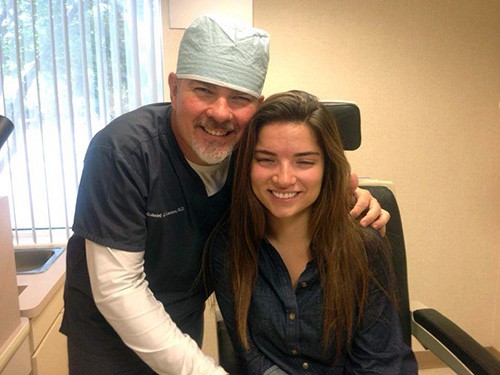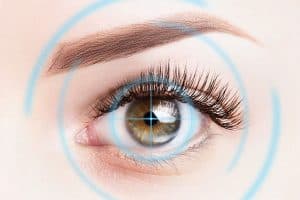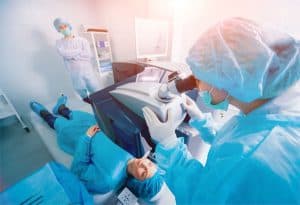Also serving patients in Fort Lauderdale

Dr. Gabriel Lazcano, eye surgeon at the Laser Eye Center of Miami, specializes in LASIK surgery in Miami and Fort Lauderdale. He has treated thousands of patients and helped them eliminate their dependence on glasses or contact lenses.
Our center is proud to be the first and only center in Miami-Dade county to offer the most advanced bladeless vision correction technology with the WaveLight® Refractive Suite, fastest refractive surgery platform available in the U.S. The Refractive Suite includes the WaveLight®FS200 Femtosecond Laser, which integrates many new functions for fast, effective and reliablefemtosecond laser treatments. This system enables
standard flap creation in approximately 6.0 seconds. And, the WaveLight®EX500 Excimer Laser combines a number of innovations in refractive technology to produce fast, effective and reliable procedures.

Imagine waking up and seeing the alarm clock without searching for your glasses. Imagine enjoying your favorite sport without contacts or glasses. For millions of people, these dreams have come true! It is truly a miracle of modern medical technology.
Which Laser Eye Surgery is Best For Me?
The ultimate decision regarding the surgery that is best suited for you will be discussed with your eye doctor.
Bladeless LASIK (LASER ASSISTED IN-SITU KERATOMILEUSIS):
- Using anesthetic eye drops only, your eyes become completely numb — NO PAIN!
- A special instrument is then placed between your eyelids to prevent blinking.
- Next, using the femtosecond laser, a thin layer of corneal tissue (flap) is created. The dimension of this layer is exactly as specified by the laser. (Traditionally, a blade was used to create the layer, but the size and thickness were very unpredictable). This flap is lifted from the cornea as if opening the cover of a book.
- Using the latest and fastest technology for LASIK surgery, a cool beam of light from the laser gently reshapes the surface of the cornea, making it more like a normal eye. This allows images to come to focus clearer on the retina, which is the back of the eye.
- The flap is put back into place, where it bonds securely without the need for stitches.
Most patients are back to their normal activities the following day and already enjoying the benefits of LASIK.
ASA (Advanced Surface Ablation):
This procedure is usually done on patients with thin corneas.
- Using “eye drops” only anesthetic eye drops, your eyes become completely numb — NO PAIN!
- A special instrument is then placed between your eyelids to prevent blinking.
- Next, the corneal “skin” (epithelium) is loosened using diluted alcohol and it is gently removed, exposing the corneal stroma.
- Using the latest technology available, a cool beam of light gently reshapes the surface of the cornea, making it more like a normal eye. Light can then focus at the back of the eye, on the retina, making images on the retina clear, thereby improving vision.
- A special chemical is applied to facilitate the healing of the tissue. A contact lens is then applied for comfort.
You should expect some discomfort for the first 2 to 3 days. Vision usually begins to improve in 3 to 4 days.

Dr. Lazcano does surgery on his daughter.
Problems That LASIK Can Correct
 LASIK is a great solution for overcoming the three most common types of refractive errors, which are eye disorders that result in blurry vision:
LASIK is a great solution for overcoming the three most common types of refractive errors, which are eye disorders that result in blurry vision:
Myopia (Nearsightedness): While you can see close-up objects clearly, objects that are far away become increasingly blurry. This occurs because the curvature of the cornea is sharper than normal, and the incoming light rays refract in front of the retina.
Hyperopia (Farsightedness): Here, your distance vision is good while your near vision is blurry. This condition occurs when the curvature of the cornea is flatter than normal, causing the incoming light rays to refract behind the retina.
Astigmatism: This condition is caused by a combination of corneal curvature irregularities that can cause vision problems at various distances.
Benefits of LASIK
Some of the reasons Dr. Lazcano’s patients are glad they had LASIK include:
- Crisper, clearer vision
- Less dependence on wearing glasses or contact lenses (with some patients no longer needing prescription lenses at all)
- Fast procedure
- Minimal discomfort
- Results that last a lifetime for most patients
LASIK Recovery
LASIK is an easy procedure to undergo and recover from, with only a brief downtime. Typically, your sight is impaired for about one day before you achieve vision crisper than it was prior to surgery. Some discomfort may linger for the initial hours after LASIK, but this can be easily managed with pain medication. Full recovery and vision can take a few months to achieve, but you should not have trouble seeing or engaging in normal activities in the meantime.
LASIK Costs
We offer LASIK at an extremely competitive rate for the quality of care we provide. Please check out our Specials page to see our latest deal on LASIK. Because LASIK is an elective procedure, it is not covered by insurance. However, your vision insurance may offer a discount for refractive surgery — check your policy for details. Financing options are available through CareCredit, a leading medical lender, for patients who would prefer to make payments toward the total cost of LASIK.
Although LASIK is more expensive than eyeglasses and contact lenses in the short-term, many patients consider it a smart investment. A couple decades of paying for prescription lenses can wind up costing more than LASIK does. In the long-term, the convenience of LASIK seems well worth the price.
Patient Review

![]() First and foremost. I would like to thank the Staff from the Laser Eye Center of Miami for making my visit and, especially, my procedure a pleasant one. At first I was hesitant to try Lasik surgery due to the idea of having a procedure done in my eyes. But fortunately I was well educated on the matter from the professional staff beforehand and they made me feel comfortable that everything will go well. As it did. They explained to me the procedure in detail as well as the recuperation process that I will undergo. It’s been 2 weeks since my operation and I have to say that my vision is perfect! I wake up in the morning appreciating life a little bit more and its thanks to the Laser Eye Center of Miami and Dr. Gabriel Lazcano.
First and foremost. I would like to thank the Staff from the Laser Eye Center of Miami for making my visit and, especially, my procedure a pleasant one. At first I was hesitant to try Lasik surgery due to the idea of having a procedure done in my eyes. But fortunately I was well educated on the matter from the professional staff beforehand and they made me feel comfortable that everything will go well. As it did. They explained to me the procedure in detail as well as the recuperation process that I will undergo. It’s been 2 weeks since my operation and I have to say that my vision is perfect! I wake up in the morning appreciating life a little bit more and its thanks to the Laser Eye Center of Miami and Dr. Gabriel Lazcano.![]() ~ Paul Sanchez
~ Paul Sanchez
LASIK FAQ
Who is a Candidate for LASIK?
 Most adults qualify for LASIK if their vision has stabilized. Your eyesight changes as you go through puberty and continues into your 20s, but your prescription will change less and less as you reach visual maturity. When your vision prescription stays the same for at least one to two years, you may be a candidate for LASIK.
Most adults qualify for LASIK if their vision has stabilized. Your eyesight changes as you go through puberty and continues into your 20s, but your prescription will change less and less as you reach visual maturity. When your vision prescription stays the same for at least one to two years, you may be a candidate for LASIK.
LASIK candidates need to have healthy eyes with no medical conditions that may complicate the procedure or recovery. Our ophthalmologists need sufficient corneal tissue to create the LASIK flap during laser eye surgery. Patients with thin corneas may be a better fit for PRK or refractive lens exchange.
Our eye surgeons can determine if LASIK is the best route to better vision for your eyes during your consultation at Laser Eye Center of Miami.
Can You Be “Too Old” to Have LASIK?
There’s no such thing as too old for LASIK, but there is an age range for the best results (25 to 40). That’s because people over 40 are likely experiencing or about to experience presbyopia, which is the age-related hardening of the eye’s natural lens. People under 25 may still have fluctuating vision as their eyes mature. Your eye lens works like a camera lens, adjusting the focus to see objects clearly, whether far away or up close. That flexibility wanes with age, and the lens can’t accommodate the change in distance for near vision anymore. Presbyopia is why most adults need reading glasses or readers in their 40s.
LASIK focuses on refractive errors from an abnormally shaped cornea, but presbyopia is an issue with the natural lens inside the eye (behind the pigmented iris). Laser eye surgery can correct vision problems from nearsightedness, farsightedness and astigmatism but won’t improve blurry near vision caused by presbyopia.
People with presbyopia who are interested in vision correction may qualify for clear lens extraction, which can correct for presbyopia and other refractive errors by replacing the natural eye lens with an artificial intraocular implant.
How Soon Can I See After Laser Eye Surgery?
 How quickly you see clearly after LASIK can vary based on how poor your vision was before the procedure and based on how your recovery goes. Though still slightly blurry, many people enjoy better vision the first day after laser eye surgery and may legally drive then. LASIK patients typically return to work a few days after LASIK, but vision continues to improve for one to two months.
How quickly you see clearly after LASIK can vary based on how poor your vision was before the procedure and based on how your recovery goes. Though still slightly blurry, many people enjoy better vision the first day after laser eye surgery and may legally drive then. LASIK patients typically return to work a few days after LASIK, but vision continues to improve for one to two months.
You’ll likely notice a significant improvement in your eyesight a few hours after LASIK when you can remove the protective eyewear and take in a clearer view of the world around you.
What are the Risks of LASIK?
LASIK is a safe and effective eye surgery that takes mere minutes per eye; but like all procedures, it does carry some risk. Side effects after LASIK are often temporary and rarely last. Dry eyes and vision fluctuations are common in the first month, though some patients (especially those with thin corneas or high myopia) may experience chronic dry eyes.
After LASIK eye surgery patients may experience the following issues, which are typically temporary but could be permanent:
- Glare
- Halos around lights
- Light sensitivity
- Specks of red or pink on the whites of the eyes
- Eye infection (rare)
- Worsening vision, or loss of best-corrected eyesight (rare)
- Blindness (rare)
Sometimes LASIK under- or overcorrects vision, requiring a second laser eye surgery or corrective eyewear.
Choosing a highly-trained and experienced eye surgeon who uses the latest technology to perform LASIK, such as our experts at Laser Eye Center of Miami, may mitigate some of these complications.
What is PRK?
Learn More
To learn more about laser eye surgery procedures we offer or other services such as cataracts and glaucoma, please contact our Miami office by calling (305) 443-4733 to schedule a consultation.







